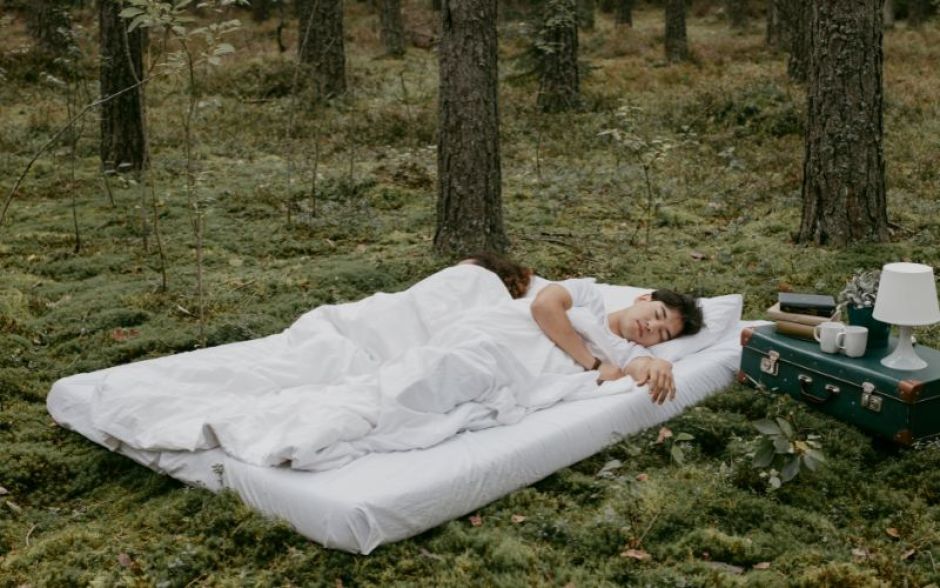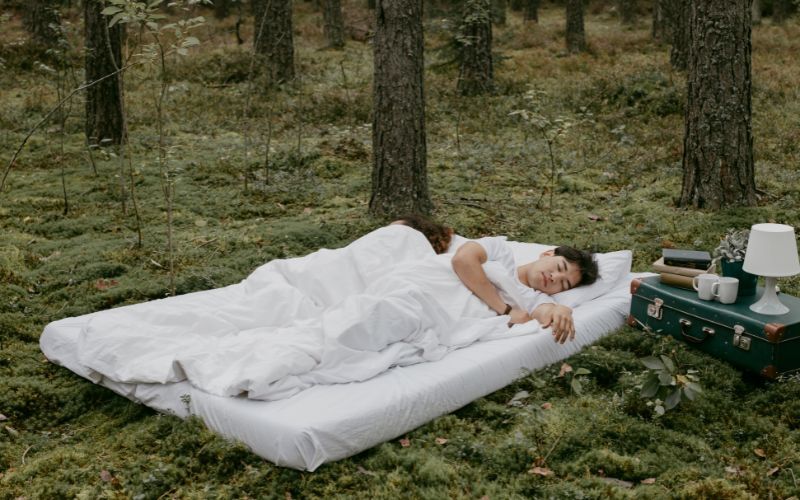
Sleeping Gear : The Quintessential Super Guide to Trekking Essentials 2023
Sleeping Gear – Trekking is a sublime blend of challenge and rejuvenation, pushing one’s limits by day and retreating into nature’s embrace by night. While the adrenaline of the trail might dominate daytime thoughts, nighttime is about restoration. As the stars claim the sky and the cold sets in, your sleeping gear becomes the barrier between you and the wilderness. High-quality, appropriate sleeping gear is more than a comfort—it’s a non-negotiable necessity. This comprehensive guide dives deep into the critical world of sleeping gear, a pivotal sub-category of trekking essentials.

Table of Contents
Understanding the Components of Sleeping Gear
In the world of trekking, where every ounce of gear matters, the components of your sleeping gear are not to be taken lightly. They are the unsung heroes of your outdoor escapades, silently working to ensure your restful slumber amidst the harshest of environments. To truly appreciate the significance of these components, let us dissect and delve into their roles and importance.
Sleeping Bags: These are the fortresses of your nocturnal sanctuary, designed to shield you from the unrelenting cold of the ground. The insulation they provide is paramount, and the choice between down and synthetic insulation is a critical one. Down insulation offers unparalleled warmth-to-weight ratio, making it the choice for those who demand efficiency in their gear. However, it comes at a price and is less effective when wet. On the other hand, synthetic insulation is robust, dries quickly, and retains warmth even in damp conditions. Your choice should be a meticulous balance between warmth, weight, and budget.

Sleeping Pads: While sleeping bags take care of your upper half, sleeping pads are the unsung heroes for your lower half. These unassuming companions serve a dual purpose: insulation and cushioning. From inflatable pads that offer adjustable firmness to closed-cell foam pads known for their durability and cost-effectiveness, the selection should be based on your personal preferences and terrain. The critical metric here is the R-value, which quantifies the pad’s ability to resist heat transfer. The higher the R-value, the more effectively it will insulate you from the cold ground.
Pillows: In the minimalist world of trekking, every gram counts. Yet, the importance of a trekking pillow cannot be overstated. These compact and lightweight wonders offer head and neck support, making the difference between a restless night and a rejuvenating sleep. They are designed for those who value comfort and understand that sleep quality can be the linchpin of a successful trek.
Liners: Liners, often overlooked, serve two vital functions. They add an extra layer of warmth when needed, allowing you to adapt to varying temperature conditions. More significantly, they maintain hygiene within your sleeping bag, preventing the buildup of sweat, dirt, and odors. This not only ensures a more comfortable sleeping environment but also prolongs the life of your sleeping bag.
In essence, understanding the components of your sleeping gear is akin to comprehending the layers of protection that insulate you from the harsh realities of the wilderness. Each component plays a unique role in maintaining your comfort, warmth, and well-being. As a trekker, it is your responsibility to meticulously choose and maintain these components, as they are your allies in the relentless battle against the elements, ensuring that your nights are restful and your days are filled with adventure.
Types of Sleeping Bags – Sleeping Gear
In the realm of trekking, the selection of a sleeping bag is not a mere matter of aesthetics or personal preference. It is a pivotal decision that can mean the difference between a restful night’s sleep and a miserable, shiver-filled night under the stars. Understanding the types of sleeping bags and their distinctive features is an imperative step in equipping yourself for the unpredictable wilderness. Here, we explore the various types of sleeping bags, each tailored to meet specific demands of the outdoor adventurer.

a. Mummy Bags: These are the aristocrats of the sleeping bag world, renowned for their snug fit and efficient insulation. The tapered design, with a hood that can be cinched tight around your head, minimizes dead air space and retains warmth effectively. Mummy bags are the go-to choice for those embarking on cold-weather excursions or treks at higher altitudes where frigid temperatures reign supreme. Their compactness and weight efficiency make them the preferred option for ultralight backpackers who value every ounce in their pack.
b. Rectangular Bags: For those who prioritize spaciousness and freedom of movement over thermal efficiency, rectangular sleeping bags are the answer. They offer ample room to stretch and move about comfortably, making them an excellent choice for warmer climates or casual camping trips. However, it’s worth noting that the rectangular design may not retain heat as efficiently as the mummy bags. Thus, they are better suited for less demanding environments where weight and pack size are not critical factors.

c. Double Bags: When trekking with a partner or a child, double sleeping bags come to the rescue. These spacious bags are designed to accommodate two occupants, ensuring warmth, intimacy, and shared comfort during cold nights in the wild. They are ideal for couples or parent-child trekking duos, fostering a sense of togetherness amidst the solitude of nature.
Each type of sleeping bag serves a specific purpose, and the choice should align with your intended adventure and the prevailing environmental conditions. A mummy bag is indispensable when venturing into freezing temperatures, while a rectangular bag offers roomy respite in more temperate climes. Double bags, on the other hand, are designed to foster companionship during outdoor journeys. In the quest for the perfect sleeping bag, one must weigh the trade-offs between warmth, weight, and space to find the ideal balance that ensures a comfortable and restful night’s sleep amidst the unpredictable backdrop of the wilderness.
Temperature Ratings – Sleeping Gear
In the realm of outdoor exploration, understanding temperature ratings is a non-negotiable aspect of equipping oneself for the unpredictable and often harsh environments encountered during treks and expeditions. These temperature ratings serve as the compass guiding your choice of sleeping bag, a decision that can significantly impact your well-being in the wild. Here, we delve into the nuances of temperature ratings, shedding light on the critical information they provide.
a. Summer: A sleeping bag with a temperature rating of +32°F and higher is classified as a summer bag. These bags are engineered to provide comfort during warm weather adventures, where the primary concern is staying cool rather than keeping warm. They are characterized by lighter insulation and superior ventilation, ensuring you don’t overheat on those balmy nights under the stars.
b. Three-Season: Falling within the temperature range of +10°F to +32°F, three-season sleeping bags are the workhorses of outdoor enthusiasts. These bags strike a delicate balance between warmth and versatility, making them suitable for a wide array of conditions encountered during spring, summer, and fall. They offer protection against chilly nights without being overly stifling in warmer weather.
c. Winter: When the mercury dips to +10°F and lower, winter sleeping bags come into play. These are the heavyweight champions of insulation, designed to keep you toasty in the most frigid of environments. Winter bags are typically equipped with additional insulation, draft collars, and heat-retaining features to combat the biting cold and ensure a restful night’s sleep when the world outside is blanketed in snow and ice.
Understanding the temperature rating of a sleeping bag is paramount. It delineates the lowest temperature at which the bag will keep the average sleeper comfortably warm. However, it is essential to remember that these ratings are guidelines and can vary between manufacturers. Personal comfort levels, metabolism, and layering also play a role in determining the suitability of a sleeping bag for specific conditions.
In the quest for the perfect sleeping bag, the temperature rating is your compass. It ensures that your choice aligns with the climate and season you are confronting, allowing you to stay comfortable and safe during your outdoor escapades. By paying heed to these temperature ratings, you equip yourself with the knowledge needed to make informed decisions and ensure that your sleeping bag becomes your reliable fortress against the capricious whims of Mother Nature.
Sleeping Pad Types and R-Value – Sleeping Gear
In the realm of outdoor exploration, where the unforgiving terrain and unpredictable weather often dictate the conditions of rest, the selection of a suitable sleeping pad is not to be underestimated. Sleeping pads are the unsung heroes of your outdoor sleep system, providing both insulation from the cold ground and cushioning for a comfortable night’s rest. Understanding the different types of sleeping pads and the significance of their R-value is pivotal in ensuring a restful and restorative night in the wilderness.
a. Air Pads: These sleeping pads are lauded for their lightweight design and adjustable firmness, affording you the luxury of customizing your sleep experience. Air pads are typically equipped with an integrated inflation system, allowing you to inflate them to your desired level of comfort. However, they come with a vulnerability—punctures. While they offer superb cushioning and insulation, a single sharp object on the ground can disrupt your night’s sleep. This makes them better suited for careful, well-maintained environments.
b. Self-inflating Pads: Combining the benefits of foam and air, self-inflating pads offer a harmonious blend of comfort and insulation. These pads contain an internal foam core that expands when the valve is opened, self-inflating to a predetermined level of firmness. They provide excellent cushioning and insulation while offering more resilience against punctures compared to pure air pads. Self-inflating pads strike a balance between comfort, insulation, and durability, making them a favored choice for many outdoor enthusiasts.
c. Closed-cell Foam Pads: Known for their durability, lightweight nature, and affordability, closed-cell foam pads are the rugged workhorses of the sleeping pad world. These pads are composed of dense foam with a closed-cell structure, making them virtually impervious to punctures. While they may lack the plush comfort of air or self-inflating pads, they excel in providing reliable insulation and dependable cushioning. Their simplicity and reliability make them the go-to choice for trekkers seeking a low-maintenance sleep solution.
The key metric to assess the insulating properties of a sleeping pad is the R-value. This value quantifies the pad’s ability to resist the flow of heat, which is essential for retaining your body’s warmth in colder conditions. A higher R-value indicates superior insulation, making the pad suitable for colder weather and higher altitudes. Conversely, a lower R-value is adequate for warmer conditions.
Understanding the type of sleeping pad and its R-value is not a trivial matter—it is the difference between a cozy, restful night’s sleep and a night spent shivering in discomfort. Your choice should be a meticulous balance between factors like weight, durability, insulation, and the specific demands of your outdoor adventure. By delving into the nuances of sleeping pad types and the R-value, you equip yourself with the knowledge necessary to select the perfect pad that complements your needs and ensures a rejuvenating night’s rest, regardless of the challenges nature may throw your way.
Importance of Shape and Fit – Sleeping Gear
In the rigorous world of trekking and outdoor adventures, the seemingly subtle factors often hold the key to a successful and restful night’s sleep. Among these critical considerations is the shape and fit of your sleeping gear, particularly your sleeping bag. It is an aspect that can significantly impact your overall insulation efficiency and, by extension, your comfort in the wilderness.
Length, Width, and Design: The right fit is more than a matter of mere convenience; it is an essential element of your insulation strategy. When it comes to sleeping bags, length, width, and design play pivotal roles:
- Length: A sleeping bag that is too short can leave your feet exposed to the cold, leading to discomfort and potential frostbite in extreme conditions. Conversely, a bag that is excessively long will result in unnecessary dead air space, making it harder to retain warmth. Therefore, selecting a bag of the appropriate length is paramount for optimizing insulation.
- Width: The width of a sleeping bag should allow you to move your limbs comfortably without compressing the insulation, which would diminish its insulating properties. A bag that is too narrow may restrict movement and result in a restless night, while one that is too wide may compromise heat retention.
- Design: The design of your sleeping bag should align with your body type and personal comfort preferences. Mummy bags, with their tapered design and snug fit, are excellent at minimizing dead air space and retaining heat efficiently. Rectangular bags, on the other hand, offer more room to move but may not be as effective at conserving warmth due to their larger internal volume.
A properly fitted sleeping bag ensures that your body is in close contact with the insulating material, minimizing the potential for heat loss. It also reduces the chances of cold drafts seeping in during the night, which can be particularly crucial in cold or windy conditions. Therefore, assessing the dimensions and design of your sleeping bag based on your body type and comfort needs is an analytical decision that pays dividends in terms of insulation efficiency and overall sleep quality.
In conclusion, the importance of shape and fit in the realm of outdoor sleeping gear cannot be overstated. It is not merely about accommodating your body; it is about optimizing insulation and creating a cocoon of warmth and comfort amidst the often harsh and unpredictable elements of nature. Your choice of sleeping gear should be a deliberate one, tailored to your individual requirements, ensuring that each night spent in the wilderness is a restful and rejuvenating experience, setting the stage for yet another day of thrilling adventure.
Materials and Insulation – Sleeping Gear
- Down Insulation: Lightweight, excellent insulation, but can be pricier and less effective when wet.
- Synthetic Insulation: Heavier, dries fast, and retains warmth when wet.
The Role of Sleep Accessories – Sleeping Gear
- Liners: Boosts warmth and keeps sleeping bags clean.
- Pillows: Compact designs that can be inflatable or use clothing for stuffing.
- Compression Sacks: Helps in packing the sleeping bag more compactly.
Caring for Your Sleeping Gear: Maintenance ensures longevity.
- Storage: Store in a dry, cool place.
- Cleaning: Follow manufacturer guidelines, generally avoiding frequent washing.
- Repair: Patch kits for pads and professional repair for sleeping bags are advisable.
Sustainability and Ethical Considerations – Sleeping Gear
Many brands are adopting eco-friendly practices, from using recycled materials to ensuring ethical down sourcing. It’s worth considering the environmental and ethical footprint of your sleeping gear.
Conclusion – Sleeping Gear
Trekking is as much a mental game as it is a physical one. After a grueling day of tackling challenging terrains, the body demands rest and recuperation. The right sleeping gear ensures this, acting as a comforting cocoon amidst nature’s unpredictability. But it’s not just about picking the most premium product; it’s about understanding your needs, the gear’s features, and making an informed, sustainable choice. As with all trekking essentials, sleeping gear demands respect, care, and thoughtful selection. After all, these are the tools that stand between the trekker and the raw elements of the wild, guaranteeing a safe, warm night before another day of adventure.
You might also like:
Sharing would be nice:
Other Trekking Essentials:
Newsletter
About me
Meet Dennis, an enthusiast of the great outdoors. For the past 15 years, he’s maintained a daily routine that includes running, hiking, and hitting the gym, embodying a commitment to an active and healthy lifestyle.
Dennis is a true advocate for the joy and rejuvenation that outdoor living can bring.



